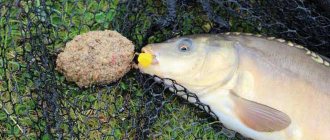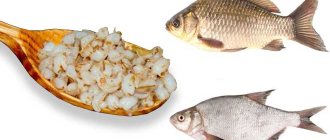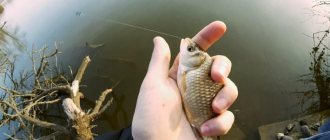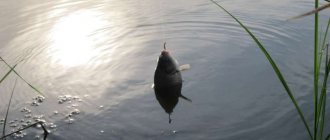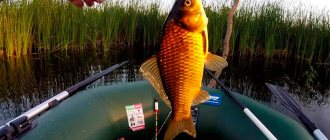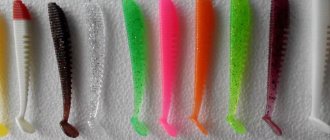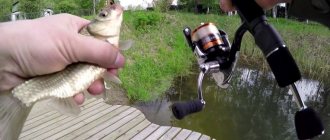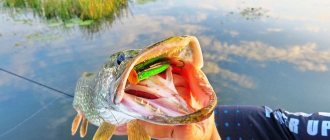Carp is a domesticated form of carp. It is found in fresh rivers, reservoirs, lakes, and other bodies of water with standing or slightly flowing water. Mirror carp is a variety of this fish with very large scales, which in some places are completely absent, the most desired trophy of every carp fisherman.
Catching a large carp is not so easy. To do this, you should study the habits and behavioral characteristics of this fish, stock up on the necessary bait and patience, which will be needed for a successful hunt for such a cautious representative of the ichthyofauna as carp.
Large carp, sometimes reaching a weight of 15 kg, and due to its mass and strength can break even a very strong fishing rod. Therefore, before you go hunting for this giant, you should properly prepare your gear and bait.
Habitats
If it is reliably known that carp lives in a given reservoir, then you should look for it in snags. In such areas of the reservoir it can be very difficult to choose a place for fishing, and hooks getting caught on snags happen regularly. But you shouldn’t move to a clean place just because the river or lake is cluttered.
The use of equipment with a sliding sinker and an offset hook will reduce the number of hooks to a minimum, and effective bites will certainly follow if this “goldfish” is offered a decent meal.
One of the very effective ways of fishing for this fish is to catch carp using a “nipple”.
What is a “nipple”?
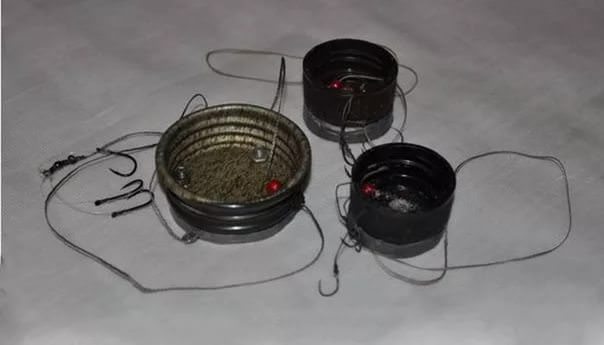
The “nipple” consists of a spring into which the bait is pressed, and hooks that are hidden inside the bait. The carp, which is attracted by this bait, comes up and begins to suck on the bait filler, as a result of which the hook occurs. An original version of this tackle is obtained if a plastic bottle cap is used as the base for the “pacifier”. In order to place small but sharp hooks inside the lid, several holes are made in the cork so that leashes with hooks can be placed inside the cork.
The hooks are camouflaged in the bait, which is located inside the lid, and when eating from this “plate”, the fish hooks itself.
When installing such gear yourself, be sure to weight the bottom of the plug so that it does not drift away with the current.
In the store, the “pacifier” is inexpensive, so you don’t have to invent a “bicycle”, but buy ready-made gear.
Accessories and additional materials for equipping homemade spinners
A homemade spinner from a spoon will require equipment with fasteners and elements for fixing the fish that pecked. For these purposes, the fisherman needs to purchase medium-sized winding rings, swivels and clasps. The best element for catching a fish that has taken a lure will be a triple hook, the size of which is selected in relation to the size of the designed product. For options with fewer hooking capabilities, soldered twins with a fastening loop are used.
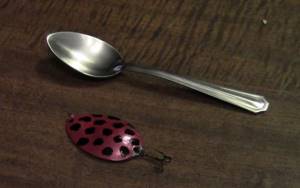
Additional elements are small silicone baits that are attached to hooks to increase attractiveness. To give a sound effect, you can use large beads or beads placed on the shank of the hook. Polyethylene and polyester rigid threads with eye-catching colors are used as tee feathering. To give the spinners a variety of colors, the angler needs multi-colored markers with the ability to draw on metal surfaces. All these elements will help you make a pike lure in the most attractive working form.
Making a “nipple” for carp with your own hands
If a fisherman decides to test himself in the skill of independently making gear for carp fishing, then this work should begin after all the necessary materials and tools have been prepared.
For the “pacifier” you may need:
- Cork from a plastic bottle.
- A flat lead sinker with an eye, weighing 10 g.
- Drill and metal drill bit with a diameter of 2 mm.
- Hooks number 6-8 and braided line with a diameter of 0.15 mm.
- Self-tapping screw for metal, with a wide head, 3 mm in diameter and up to 15 mm in length.
Installation process:
- The plastic plug is installed on a flat sinker so that the center of the plug is aligned with the center of the sinker.
- Using a 2 mm drill, a through hole is made exactly in the center of the plug and sinker.
- A self-tapping screw is screwed into the hole on the side of the plug.
- Along the side circumference of the cork, 4 holes with a diameter of 2 mm are drilled, equidistant from each other, into which leashes 5-6 cm long are inserted, so that the hooks are inside the cork. The free ends of the leashes are tied to the eye of the sinker. The tackle is ready!
When installing a “nipple”, if the length of the screw is greater than the total thickness of the bottom of the plug and the sinker, the part of the screw coming out of the sinker should be sawed off.
Hooks should be equipped with foam balls so that the fish, when sucking the bait, do not feel the prick from the sharp sting of the hook.
“Nipple” from a spoon
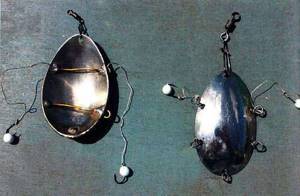
The advantage of this design is that the “nipple” does not need to be additionally equipped with a sinker; the metal of the spoon copes well with the function of weighing the bait. To make such gear you will need the following materials and tools:
- Stainless steel tablespoon.
- Copper wire with a diameter of 2 mm.
- Hooks numbers 6-8 and braided fishing line with a diameter of 0.15 mm.
- Drill and drill bit for metal with a diameter of 2 and 4 mm.
- Hacksaw for metal.
- File.
Using a hacksaw for metal, the handle of the spoon is sawed off at the point where it attaches to the scooping part of this cutlery. The place where the metal was separated should therefore be carefully processed with a file so that there are no sharp edges that could damage the fishing line.
At the sawing site, moving 2-3 mm from the edge, it is necessary to drill a hole with a diameter of 2 mm to attach the fishing line to this tackle. The hole must be chamfered on both sides using a larger diameter drill.
Two-millimeter holes should be drilled on each side of the spoon in the amount of 4 pieces, 2 holes on each side. When drilling these holes, you should also step back slightly from the edge.
2 pieces 4-5 cm long are separated from the copper wire. Each piece is bent in an arc and installed in opposite holes of the spoon and fixed in the hole by crimping the metal on both sides.
Leashes, in the amount of 4 pieces, with hooks are tied to the main hole for attaching the main fishing line, and are placed inside the tackle after the bait is placed inside this structure.
“Nipple” made from a spring
You can make a spring for the tackle yourself.
Copper wire with a diameter of 3 mm is successfully used for this purpose. The wire is wound onto a tube or rod with a diameter of 15-20 mm. The number of turns and the step between them are selected individually, but too large a distance between turns is undesirable due to unsatisfactory retention of the bait in such gear.
The fastening of the “nipple” of this design is blind; the main line is tied directly to the coils of such a spring. Leashes with hooks are also attached to the spring.
Basic principles of nipple fishing
Like any other method of fishing, nipple fishing has its own distinctive features and rules that must be followed. It is very important to assemble the tackle correctly; each element must correspond to each other.
a braided cord with a diameter of 0.2 mm as the main fishing line , then the leashes should be no thicker than 0.15 mm , and the carabiner must be chosen with sufficient power to withstand not only the casting of a charged feeder - sinker, but also the resistance of the trophy fish when playing her out.
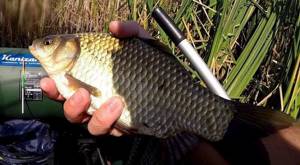
Always choose your fishing spot carefully . Fishing with this gear does not involve active movements, so if you make a mistake, you can lose a lot of time before the decision comes to change this place to another.
One of the most important elements when fishing with nipples is, of course, the bait. It must meet the following requirements:
- be dense and at the same time viscous;
- it should be little washed out with water;
- the most important thing is that it must be attractive to fish.
Experienced fishermen prefer to prepare bait themselves, taking into account the preferences of a particular type of fish. Often the bait base, prepared in large quantities, is divided into several parts to add different flavors to each of them. The main ingredient is often ordinary semolina , which, if properly prepared, can remain in the feeder for quite a long time and is a good connecting link for the other components.
Recipes for making porridge for pacifiers
The success of carp fishing with this tackle depends on the quality of the bait used.
You can prepare bait at home; several highly effective recipes for preparing carp bait are suitable for this fishing method.
Semolina
Cook the semolina porridge in enough water over low heat for 10 minutes. Then unrefined vegetable oil is added to the porridge.
After the porridge has cooled, it can be used for its intended purpose.
Barley porridge
Barley porridge is cooked in the same way as semolina, but the cooking time should be increased to 20 minutes.
Mastyrka
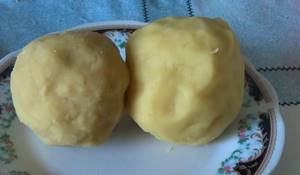
To prepare mastyrka you will need:
- Peas.
- Semolina.
- Unrefined vegetable oil.
The bait is prepared in the following sequence:
- Peas are soaked in water for several hours.
- Then cook for 1 hour in an enamel bowl.
- After the peas are completely cooked, add semolina and cook the mixture over low heat for another 10 minutes.
- After the mastyrka is prepared, vegetable oil is added to the porridge.
This bait can be flavored not only with sunflower oil, but also with various products and attractants that can interest even passive carp.
Among these products, the following can be particularly highlighted:
- honey,
- canned corn juice,
- vanilla,
- garlic.
In cold water, artificial attractants with animal odors such as shrimp, crab or maggot will work better.
Cereals
This bait option is used when there is no time to prepare more complex bait compositions.
Oatmeal is poured with boiling water and left for 15-20 minutes. After which you can use this bait for its intended purpose.
Hominy
To prepare this bait you will need cornmeal. The porridge should be cooked in a container with thick walls, since burnt bait will be completely uninteresting to such a gourmet as carp.
Sequencing:
- Water is poured into the pan and placed on fire.
- After the water boils, add corn flour, stirring continuously.
- Then the porridge is cooked for 20 minutes over very low heat. You can use hominy either in its natural form or with flavorings.
Beans
This nozzle is prepared in the following sequence:
- The beans are cooked for 1.5 hours in an enamel bowl.
- Then wheat grits are added to the pan and cooked for another 15 minutes.
- To prepare this bait, products are taken in the ratio: beans - 5 parts by weight, wheat grits - 1 part.
- After the prepared mixture has cooled, it can be used for its intended purpose.
How to make a spoon from a spoon handle
Knowledgeable fishermen make homemade baits from the cuttings, arguing that they play in the water interesting for the fish and have a symmetrical shape. After all, with careful decoration, the appearance will imitate a small fish.
But from the handle of an aluminum device they create an analogue of an expensive one.

It is recommended to use a steel spoon as the basis for such vibrators. They will not require additional shipping and will perform well in bodies of water with strong currents.
In addition, you can experiment with the body of the spinner and make it straight or wavy. If in the first case, a lot of skills will be required from the spinning angler so that the bait actively plays in the water. In the second, by bending the workpiece to the required radius, you won’t have to make any special efforts to get a bright game in the water.
Let's look at how to make a vibrator from a stem with a straight body by hand. To do this you need:
- Cut 15–20 mm from the thin part of the handle. So the bait will look like bleak.
- Drill holes in the workpiece for the winding rings. Remove burrs with a file. Paste them.
- You need to put on a tee on the wide side of the handle, and fix the fishing line on the narrow side. In the version with an aluminum blank, the fasteners are performed in reverse.
The resulting spoon can be used for reservoirs with different current strengths. The type of wiring is selected individually.
Techniques and tactics of catching carp on a “nipple”
Before you start catching carp on the “nipple”, you should choose the right place for this type of fishing. This gear is not a sporting one, due to the fact that the fish hooks itself, so you can effectively control several fishing rods that are cast in different directions.
Prospective casting of the “nipple” can be carried out where there are places bordering on aquatic vegetation or a snagged area of the reservoir.
The bait is pressed tightly into the tackle, while the hooks must be completely camouflaged inside.
In order for the carp to become interested in exactly the area of the bait where the hook is hidden, peculiar bulges should be formed.
When a large carp approaches such a “nipple” and starts sucking it, the fish is hooked by a hook hidden in the thickness of the bait.
Carp: how to catch with a “nipple”?
Carp is a domesticated form of carp.
It is found in fresh rivers, reservoirs, lakes, and other bodies of water with standing or slightly flowing water. Mirror carp is a variety of this fish with very large scales, which in some places are completely absent, the most desired trophy of every carp fisherman. Catching a large carp is not so easy. To do this, you should study the habits and behavioral characteristics of this fish, stock up on the necessary bait and patience, which will be needed for a successful hunt for such a cautious representative of the ichthyofauna as carp.
Large carp, sometimes reaching a weight of 15 kg, and due to its mass and strength can break even a very strong fishing rod. Therefore, before you go hunting for this giant, you should properly prepare your gear and bait.
Tips and tricks
- Catching carp with a “nipple” is reminiscent of feeder fishing, so a feeder rod, reel and fishing line are used to mount the gear.
The quality of all components of this tackle must be very high; large carp test the strength of the tackle very harshly in the first minutes after hooking. - Carp is a very cautious fish, so when choosing a place for fishing, you should avoid all kinds of resting and swimming areas. Carp can be caught well only if the fisherman maintains complete silence, and the only natural sounds above the pond are the singing of birds and the rustling of the wind in the branches of trees.
- You can catch carp quite effectively with this type of gear at night. In this case, a bell is used to signal bites.
- You can string corn onto a hook that is hidden in the bait layer; in this case, hooking will follow even if the hook is washed out by the current and is located in close proximity to the feeder.
- Usually, hooking a fish when using a “nipple” occurs independently , but you should not delay in landing the fish. The hook can get caught on the fish’s lip, and with a strong jerk, the carp can free itself from the tackle, so with pronounced movements of the fishing line, which signal that it is hooked there is a fish, you should immediately land the fish, being careful, and when there is a large carp on the hook, you must use a landing net.
- run out of bait while fishing for carp with this bottom tackle , then you can use white bread with great success. The bread crumb can be flavored, which will further attract carp to the feeder.
- One of the promising places for carp fishing is areas of a reservoir with tree branches hanging low over the water.
- This fish loves to feed in such places on insects falling from trees, and if you cast a “nipple” in this place, you can catch very worthy representatives of this breed of fish. In such places it is necessary to make very precise casts so as not to miss and throw the tackle onto a tree. In this case, getting the tackle undamaged will be very difficult.
- The good thing about carp fishing is that even a beginner can catch a trophy carp even if he has absolutely no experience in this type of fishing. Therefore, at the preparation stage, it is only important to weld the bait correctly, throw the tackle into the most promising place for carp fishing, and wait for bites from large and small fish.
